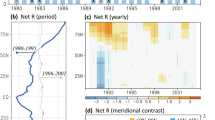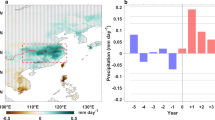Abstract
Volcanic activity plays a strong role in modulating climate variability1. Most model projections of the twenty-first century, however, under-sample future volcanic effects by not representing the range of plausible eruption scenarios2,3,4. Here, we explore how sixty possible volcanic futures, consistent with ice-core records5, impact climate variability projections of the Norwegian Earth System Model (NorESM)6 under RCP4.5 (ref. 7). The inclusion of volcanic forcing enhances climate variability on annual-to-decadal timescales. Although decades with negative global temperature trends become ∼50% more commonplace with volcanic activity, these are unlikely to be able to mitigate long-term anthropogenic warming. Volcanic activity also impacts probabilistic projections of global radiation, sea level, ocean circulation, and sea-ice variability, the local-scale effects of which are detectable when quantifying the time of emergence8. These results highlight the importance and feasibility of representing volcanic uncertainty in future climate assessments.
This is a preview of subscription content, access via your institution
Access options
Access Nature and 54 other Nature Portfolio journals
Get Nature+, our best-value online-access subscription
$29.99 / 30 days
cancel any time
Subscribe to this journal
Receive 12 print issues and online access
$209.00 per year
only $17.42 per issue
Buy this article
- Purchase on Springer Link
- Instant access to full article PDF
Prices may be subject to local taxes which are calculated during checkout





Similar content being viewed by others
References
Schurer, A. P., Tett, S. F. B. & Hegerl, G. C. Small influence of solar variability on climate over the past millennium. Nat. Geosci. 7, 104–108 (2014).
Kirtman, B. et al. in Climate Change 2013: The Physical Science Basis (eds Stocker, T. F. et al.) 953–1028 (IPCC, Cambridge Univ. Press, 2013).
Taylor, K. E. et al. An overview of CMIP5 and the experiment design. Bull. Am. Meteorol. Soc. 93, 485–498 (2012).
O’Neill, B. C. et al. The Scenario Model Intercomparison Project (ScenarioMIP) for CMIP6. Geosci. Model Dev. 9, 3461–3482 (2016).
Sigl, M. et al. Timing and climate forcing of volcanic eruptions for the past 2,500 years. Nature 523, 543–549 (2015).
Bentsen, M. et al. The Norwegian Earth System Model, NorESM1-M—Part 1: description and basic evaluation of the physical climate. Geosci. Model Dev. 6, 687–720 (2013).
Vuuren, D. P. et al. The representative concentration pathways: an overview. Climatic Change 109, 5–31 (2011).
Hawkins, E. & Sutton, R. Time of emergence of climate signals. Geophys. Res. Lett. 39, L01702 (2012).
Hyde, W. T. & Crowley, T. J. Probability of future climatically significant volcanic eruptions. J. Clim. 13, 1445–1450 (2000).
Parker, D. E. & Brownscombe, J. L. Stratospheric warming following the El Chichón volcanic eruption. Nature 301, 406–408 (1983).
Robock, A. & Mao, J. The volcanic signal in surface temperature observations. J. Clim. 8, 1086–1103 (1995).
Iles, C. E. & Hegerl, G. C. Systematic change in global patterns of streamflow following volcanic eruptions. Nat. Geosci. 8, 838–842 (2015).
Liu, F. et al. Global monsoon precipitation responses to large volcanic eruptions. Sci. Rep. 6, 24331 (2016).
Shindell, D. T., Schmidt, G. A., Mann, M. E. & Faluvegi, G. Dynamic winter climate response to large tropical volcanic eruptions since 1600. J. Geophys. Res. 109, D05104 (2004).
Miller, G. H. et al. Abrupt onset of the Little Ice Age triggered by volcanism and sustained by sea-ice/ocean feedbacks. Geophys. Res. Lett. 39, L02708 (2012).
Gleckler, P. J. et al. Volcanoes and climate: Krakatoa’s signature persists in the ocean. Nature 439, 675 (2006).
Stenchikov, G. et al. Volcanic signals in oceans. J. Geophys. Res. 114, D16104 (2009).
Swingedouw, D. et al. Bidecadal North Atlantic ocean circulation variability controlled by timing of volcanic eruptions. Nat. Commun. 6, 6545 (2015).
Otterå, O. H., Bentsen, M., Drange, H. & Suo, L. External forcing as a metronome for Atlantic multidecadal variability. Nat. Geosci. 3, 688–694 (2010).
Church, J. A., White, N. J. & Arblaster, J. M. Significant decadal-scale impact of volcanic eruptions on sea level and ocean heat content. Nature 438, 74–77 (2005).
Hansen, J. et al. Global climate changes as forecast by Goddard Institute for Space Studies three-dimensional model. J. Geophys. Res. 93, 9341–9364 (1988).
Shiogama, H. et al. Possible influence of volcanic activity on the decadal potential predictability of the natural variability in near-term climate predictions. Adv. Meteorol. 2010, 657318 (2010).
Ammann, C. M. & Naveau, P. A statistical volcanic forcing scenario generator for climate simulations. J. Geophys. Res. 115, D05107 (2010).
Mitchell, D. et al. Realizing the impacts of a 1.5 °C warmer world. Nat. Clim. Change 6, 735–737 (2016).
Self, S. & Gertisser, R. Tying down eruption risk. Nat. Geosci. 8, 248–250 (2015).
Tuel, A., Naveau, P. & Ammann, C. M. Skillful prediction of multidecadal variations in volcanic forcing. Geophys. Res. Lett. 44, 2868–2874 (2017).
Ammann, C. M., Meehl, G. A., Washington, W. M. & Zender, C. S. A monthly and latitudinally varying volcanic forcing dataset in simulations of 20th century climate. Geophys. Res. Lett. 30, 1657 (2003).
Gregory, J. M. Long-term effect of volcanic forcing on ocean heat content. Geophys. Res. Lett. 37, 045507 (2010).
Hawkins, E. & Sutton, R. The potential to narrow uncertainty in regional climate predictions. Bull. Am. Meteorol. Soc. 90, 1095–1107 (2009).
Zanchettin, D. et al. The Model Intercomparison Project on the climatic response to Volcanic forcing (VolMIP): experimental design and forcing input data for CMIP6. Geosci. Model Dev. 9, 2701–2719 (2016).
Santer, B. D. et al. Volcanic contribution to decadal changes in tropospheric temperature. Nat. Geosci. 7, 185–189 (2014).
Gao, C., Oman, L., Robock, A. & Stenchikov, G. L. Atmospheric volcanic loading derived from bipolar ice cores: accounting for the spatial distribution of volcanic deposition. J. Geophys. Res. 112, D09109 (2007).
Crowley, T. J. & Unterman, M. B. Technical details concerning development of a 1200 yr proxy index for global volcanism. Earth Syst. Sci. Data 5, 187–197 (2013).
Sigl, M. et al. A new bipolar ice core record of volcanism from WAIS Divide and NEEM and implications for climate forcing of the last 2000 years. J. Geophys. Res. 118, 1151–1169 (2013).
Sigl, M. et al. Insights from Antarctica on volcanic forcing during the Common Era. Nat. Clim. Change 4, 6–10 (2014).
Vidal, C. M. et al. The 1257 Samalas eruption (Lombok, Indonesia): the single greatest stratospheric gas release of the Common Era. Sci. Rep. 6, 34868 (2016).
Wild, M. et al. From dimming to brightening: decadal changes in Solar radiation at Earth’s surface. Science 308, 847–850 (2005).
McConnell, J. R. et al. 20th-century industrial black carbon emissions altered Arctic climate forcing. Science 317, 1381–1384 (2007).
Iversen, T. et al. The Norwegian Earth System Model, NorESM1-M—Part 2: climate response and scenario projections. Geosci. Model Dev. 6, 389–415 (2013).
Gent, P. R. et al. The community climate system model version 4. J. Clim. 24, 4973–4991 (2011).
Pausata, F. S. R., Grini, A., Caballero, R., Hannachi, A. & Seland, Ø. High-latitude volcanic eruptions in the Norwegian Earth System Model: the effect of different initial conditions and of the ensemble size. Tellus B 67, 26728 (2015).
Pausata, F. S. R., Chafik, L., Caballero, R. & Battisti, D. S. Impacts of high-latitude volcanic eruptions on ENSO and AMOC. Proc. Natl Acad. Sci. USA 112, 13784–13788 (2015).
Outten, S., Thorne, P., Bethke, I. & Seland, Ø. Investigating the recent apparent hiatus in surface temperature increases: 1. Construction of two 30-member Earth System Model ensembles. J. Geophys. Res. 120, 8575–8596 (2015).
Thorne, P., Outten, S., Bethke, I. & Seland, Ø. Investigating the recent apparent hiatus in surface temperature increases: 2. Comparison of model ensembles to observational estimates. J. Geophys. Res. 120, 8597–8620 (2015).
Efron, B. & Tibshirani, R. Bootstrap methods for standard errors, confidence intervals, and other measures of statistical accuracy. Stat. Sci. 1, 54–75 (1986).
Carlstein, E. The use of subseries values for estimating the variance of a general statistic from a stationary sequence. Ann. Stat. 14, 1171–1179 (1986).
Acknowledgements
We thank D. Mitchell, A. Kirkevåg, M. Toohey and D. Zanchettin for providing valuable input. This study was supported by the Bjerknes Centre for Climate Research, Research Council of Norway (229774) and UNINETT Sigma2 (nn9039k, ns9039k).
Author information
Authors and Affiliations
Contributions
S.O., P.T. and I.B. developed the stochastic forcing model. S.W. and M.S. helped with the utilization and interpretation of the ice-core reconstructions. I.B., P.T., S.O. and E.H. conceived and designed the simulation experiments. E.H. performed the ToE analysis. All authors contributed to writing the manuscript.
Corresponding author
Ethics declarations
Competing interests
The authors declare no competing financial interests.
Supplementary information
Supplementary Information
Supplementary Information (PDF 3105 kb)
Rights and permissions
About this article
Cite this article
Bethke, I., Outten, S., Otterå, O. et al. Potential volcanic impacts on future climate variability. Nature Clim Change 7, 799–805 (2017). https://doi.org/10.1038/nclimate3394
Received:
Accepted:
Published:
Issue Date:
DOI: https://doi.org/10.1038/nclimate3394
This article is cited by
-
Volcanic forcing of high-latitude Northern Hemisphere eruptions
npj Climate and Atmospheric Science (2024)
-
El Niño and the AMO Sparked the Astonishingly Large Margin of Warming in the Global Mean Surface Temperature in 2023
Advances in Atmospheric Sciences (2024)
-
Volcanic contribution to the 1990s North Pacific climate shift in winter
Scientific Reports (2023)
-
Regional but not global temperature variability underestimated by climate models at supradecadal timescales
Nature Geoscience (2023)
-
Sensitivity of tropical monsoon precipitation to the latitude of stratospheric aerosol injections
Climate Dynamics (2022)



